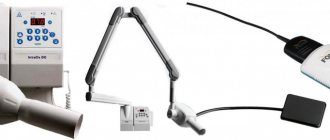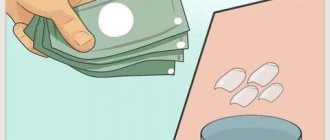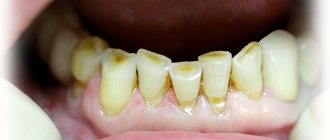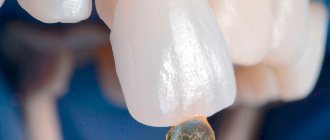The process of making dentures takes place in several stages. The first is taking a cast (impression). The subsequent ease of use of prostheses depends on how professionally this work is carried out.
You should not chase a low price; it is important to focus on the quality of work. In common practice, with rare exceptions, the dental technician does not see the patient. And he creates a prosthesis only on the basis of a cast. For this reason, the quality of the impression directly affects the comfort of wearing the orthopedic structure.
In our MK Technology clinic you will be offered several options for taking an impression before prosthetics. They may differ in cost, material used for taking the impression, and procedure time. The final decision on choosing the method of taking an impression will be yours, depending on your expectations, financial capabilities and the type of planned prosthetics.
Price for taking an impression
| Taking an impression from one jaw with alginate mass | included in the cost of prosthetics |
| Taking an impression from one jaw using C-silicone | included in the cost of prosthetics |
| Taking an impression from one jaw using A-silicone | included in the cost of prosthetics |
| Taking an impression from one jaw using an individual tray | included in the cost of prosthetics |
| Taking an impression from one jaw of a tray with an implant using the open method | included in the cost of prosthetics |
| Taking an impression from one jaw with implants using the closed method | included in the cost of prosthetics |
| Taking an impression from one jaw to make a silicone key | included in the cost of prosthetics |
| Trephination of tooth, artificial crown | 1 000 |
| Definition of bite | included in the cost of prosthetics |
| Determining the type of closure of the dentition using a facebow | included in the cost of prosthetics |
| Study on diagnostic jaw models | 2 000 |
| Study on diagnostic models of jaws with wax-up (WAx-Up) of the future prosthetic design for the purpose of planning preparation, aesthetics and function (1 unit) | 1 500 |
| Determination of occlusion by fitting in the oral cavity the result of a wax-up (Moke-Up) made of temporary composite material, planning aesthetics and function (1 unit) | 2 500 |
A dental impression is the basis of the future prosthesis. You can make a plaster model only with a high-quality cast. The model, in turn, is used to create complex orthopedic structures.
They are used for the production of:
- removable or fixed dentures
- crowns
- bridges
- individual abutments
- braces used for malocclusion
- trainers, also used in the treatment of malocclusion
The more complex the orthopedic design, the more accurate the impression must be made. Errors when transferring an impression into plaster and subsequent digitization can be so great that the adjustment of the prosthesis is carried out in several steps.
What are alginate masks made of?
The composition of an alginate mask is a little more complex than sour cream and strawberries smeared over the face, and it works more cunningly. In addition to the alginic acid salt, the composition always includes:
- a plasticizer substance is a source of calcium ions, which starts the process of hardening the mask on the face,
- a set of active components such as clays, anti-aging assets, extracts.
Sodium pyrophosphate is most often used as a plasticizer.
, which raises the most questions in the composition.
Sodium pyrophosphate in the alginate mask is responsible for the comfortable speed of its hardening on the skin. After all, the mask should be useful, that is, it should really contain a lot of alginate, and at the same time harden more slowly than in 10 seconds and be very plastic. Sodium pyrophosphate comes in several forms and can be eco-certified. For example, in SATIVA alginate masks it is in the form of “tetrasodium pyrophosphate” and is approved by the COSMOS standard.
Types of materials for taking dental impressions
Doctors use only modern and high-tech materials. Among the large selection offered by the market, the doctor focuses on the clinical situation and the specific purposes for which the impression will be used in the future.
Main criteria for material selection:
- Impression accuracy. In particular, it is necessary to accurately convey the contours of soft tissues that will be in direct contact with the prosthesis.
- Resistance to deformation after making an impression.
- The material should not be subject to shrinkage after contact with the external environment (air, light), and when exposed to an aggressive environment in the oral cavity.
Silicone-based materials are popular. They are quite plastic, so they allow you to achieve an accurate impression of all areas of the teeth, including the gingival areas. Most often they are used to create clasp models and ceramic crowns. However, it is necessary to note a significant drawback of such material - shrinkage after sixty minutes.
Pouring with plaster
Depending on what type of plaster you use to create your 3D impression, you need to consider the mass to water ratio! The resulting mass should not be too watery, but have a slightly thick, runny consistency.
Pour thin layers of plaster mixture into the 3D mold in stages to avoid creating air bubbles. Shake the container from time to time to remove any air bubbles that have formed and completely fill the mold with plaster.
Now you need to be patient. The plaster will take at least 24 hours to harden!
After drying, carefully cut the alginate mixture from the hardened plaster with a knife.
Preparing to take an impression
To create a high-quality impression, proper preparation is necessary. The quality of the impression depends on how carefully the preparatory work is carried out.
- Preparing the oral cavity. Drying using special tools and cotton swabs. At this stage, the specialist achieves the lowest possible humidity in order to avoid a negative reaction of the impression materials.
- Selection (or production of an individual) orthopedic spoon. Spoons are made from various materials, including metal. Different spoons are used for the upper and lower jaws. There are times when it is necessary to make a spoon individually. This naturally lengthens the time spent on prosthetics and increases the cost of the preparatory stage.
- Spoons can be made of metal or other material and intended for the upper or lower jaw. In some cases, it is necessary to make a custom spoon.
Now let's move on to the most interesting part - “how it works”
When we add water to an alginate mask, a real seething of chemical processes begins. One of the main ones is that sodium alginate salt begins to turn into calcium alginate and harden. Calcium, magnesium, iron, potassium, and silver ions begin to run in crowds from the mask into the skin and become embedded where they are lacking. There are a lot of trace element ions and antioxidant molecules flowing into the skin and of different compositions, which depend on the beneficial additives included in the mask. Therefore, enriching clay additives and medicinal herbal extracts will never be superfluous in an alginate mask. The skin receives a real “charge of vivacity” and looks “refreshed”.
How is the impression taken?
When the spoon has already been selected, the doctor performs the following manipulations:
- Using a spatula, the selected material is mixed.
- The mass is placed in a spoon, inserted into the mouth, and the spoon is pressed against the alveolar process. When is an impression taken from the lower jaw? press first in front, then behind. If they work with the upper jaw, then they act in the reverse order.
- To harden the mass, leave it in the mouth for no more than five minutes. During this time, the impression hardens and preserves as accurately as possible all the features of the patient’s jaw.
- The edges of the impression are formed by the movements of the patient's tongue and lips.
- To avoid deformation of the impression, it is removed in one sharp movement.
- After washing, the impression is immersed in a special solution.
Taking a dental impression with alginate mass: tips
- Give the patient a paper towel. Taking an impression is a “dirty” process, he may need it.
- The impression should begin with the molars. Having placed the spoon in the patient's mouth, first press the mass in the area of the molars, then in the area of the front teeth. Press the entire spoon down at once and you will get bubbles in the mixture.
- Hold the impression tray while the mixture hardens. If you remove your hands, the patient may move the tray with his tongue and bite it, which will ruin the impression.
- It is better to remove the spoon in one movement; if this does not work, you can pry it from one side and remove it with a rocking movement.
A set of dental posters “Prosthetics” will help you convey to patients all the most important information about this type of treatment.
https://lavka.stomanet.ru/product/komplekt-stomatologicheskih-plakatov-protezirovanie/
Follow this link to learn more about the kit and place your order. We accept payments from legal entities. persons We deliver free of charge throughout Russia.
Alginate for impressions: the best offer for dentists
In order to make a high-quality impression, alginate masses are used in dentistry - special masses that have plasticity and elasticity. This material is used to take impressions for prosthetics and bite correction.
Today, doctors have access to new impression materials that have a number of advantages. But most doctors continue to use alginates in their work - convenient, practical, inexpensive masses for making impressions. Alginate mass for impressions does not require special conditions for use; it is much easier to work with than innovative silicone fillers. An important advantage of alginates is their natural origin. The raw material for the production of this impression mass is seaweed.
Among the important advantages of alginate impression masses, the following should be noted:
- holds its shape well;
- tools do not stick to the substance.
Alginate impression mass is one of the most used materials and not every doctor can afford to buy it at a high price. Given the high consumption of material, every specialist strives to buy good, high-quality raw materials for impressions at a lower price. Today you can do this in the All4dental online store. We do not work with intermediaries and offer you high-quality materials at a price significantly lower than the cost of similar products at offline points of sale.
What are alginates
To understand what an alginate mask is, you need to understand the very definition of “alginate”. Alginate is a plastic, rubber-like substance obtained from brown algae. It is this that serves as the basis for the masks of the same name.
Alginate masks are a professional cosmetic product that demonstrates good results. You can find a unique composition for any skin type and for any problem. Well, due to the fact that all alginate masks have a bright tightening effect, ladies over 30 simply need to use them.
In a salon, applying an alginate mask can cost 1–2 thousand rubles, but if you carry out the procedure at home, then one portion of a wonderful product will cost only 200–300 rubles.
Advantages and disadvantages
The advantages of the drug include:
- high strength combined with mass elasticity;
- different range of material adhesion , which allows you to choose the product that is most suitable in each specific situation;
- high stability of initial parameters;
- rapid absorption of liquid>;
- ease of mixing the components of the product;
- minimal content of dust fragments , which eliminates the risk of inhaling dust pieces during the manipulation process;
- long shelf life in closed packaging - at least 5 years from the date of manufacture;
- a special composition that minimizes the risk of subsequent shrinkage of the mixture after hardening;
- does not spread in the patient’s mouth;
- has a pleasant taste and does not irritate soft mucous tissues;
- all substances included in the drug are made from natural ingredients and are safe for human health;
Allergic reactions of the body are a phenomenon that is isolated in nature and is classified as an exception.
Alginate-containing powders also have disadvantages:
- too large a proportion of water in the composition is fraught with long processes of hardening of the mixture;
- excessively rapid dissolution of the mass can, on the contrary, accelerate these processes;
- if the composition is kneaded without observing the technology and the required proportions, then over time it will begin to crumble;
- any discrepancy with the instructions for use will lead to a violation of the structural content of the material and a violation of its integrity in the shortest possible time.
Properties of alginate impression mass
Viscosity
Alnate impression material is quite viscous, but this directly depends on whether the paste is mixed in the correct proportion. It is very important to adhere to the correct proportions to achieve optimal viscosity.
Accuracy
The accuracy with which the alginate impression mass transfers small objects reaches a maximum of 50 m. This is somewhat less than that of silicone impression materials, so alginates are not recommended for use when taking impressions for working models that require particularly high precision.
Elasticity
The elasticity of the alginate material is such that it can be used to image undercut areas. However, its elasticity is several times less than that of other impression masses, for example, hydrocolloid ones. Alginate material collapses even at 50% pressure and at fairly low tensile loads.











